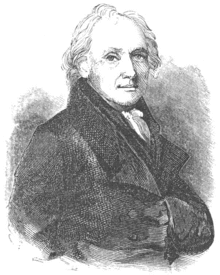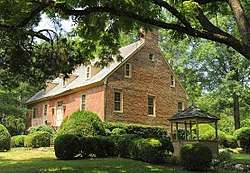Mason Locke Weems
Mason Locke Weems (October 11, 1759 – May 23, 1825), usually referred to as Parson Weems, was an American book agent and author who wrote the first biography of George Washington immediately after his death. He was the source of some of the apocryphal stories about Washington. The tale of the cherry tree ("I cannot tell a lie, I did it with my little hatchet") is included in the fifth edition of The Life of Washington (1809 imprint, originally published 1800), a bestseller that depicted Washington's virtues and was intended to provide a morally instructive tale for the youth of the young nation.[1]
Parson Weems | |
|---|---|
 Portrait of Mason L. Weems | |
| Born | Mason Locke Weems October 11, 1759 |
| Died | April 23, 1825 (aged 65) |
| Resting place | Bel-Air |
| Other names | Mason L. Weems |
| Occupation | Book agent and author |
Notable work | The Life of Washington |
Biography

Mason Weems was born on October 11, 1759, in Anne Arundel County, Maryland. He studied theology in London and was ordained in the Protestant Episcopal Church in 1784. He worked as a minister in Maryland in various capacities from 1784 to 1792. Financial hardship forced Weems to seek additional employment, and he began working as a traveling book agent. Weems married Frances Ewell in 1795 and established a household in Dumfries, Virginia. He had a small bookstore in Dumfries that now houses the Weems–Botts Museum, but he continued to travel extensively, selling books and preaching.[2]
Dumfries is not far from Pohick Church, part of Truro Parish, in Lorton, Virginia, where both George Washington and his father Augustine had worshiped in pre-Revolutionary days. Weems would later inflate this Washington connection and promote himself as the former "rector of Mount-Vernon parish".
Other notable works by Weems include Life of General Francis Marion (1805); Life of Benjamin Franklin, with Essays (1817); and Life of William Penn (1819). He was an accomplished violinist.
After the death of his father-in-law, Colonel Jessie Ewell (1743–1805), Weems assumed the Ewell family estate, Bel Air, located in Prince William County, Virginia, to partially satisfy debts owed to Weems. In 1808, Weems and his family moved into Bel Air, where he lived until his death. While on travel in Beaufort, South Carolina, Weems died on May 23, 1825 of unspecified causes. He is buried at Bel Air.[3]
Influence and historical reliability
The New York Times has described Weems as one of the "early hagiographers" of American literature "who elevated the Swamp Fox, Francis Marion, into the American pantheon and helped secure a place there for George Washington".[4]
Weems' name would probably be forgotten today were it not for the tension between the liveliness of his narratives and what Appletons' Cyclopaedia of American Biography (1889) called "this charge of a want of veracity [that] is brought against all Weems's writings," adding that "it is probable he would have accounted it excusable to tell any good story to the credit of his heroes." The cherry-tree anecdote illustrates this point. Another dubious anecdote found in the Weems biography is that of Washington's prayer during the winter at Valley Forge.[5][6]
According to the historian James M. McPherson, Weems' biography of George Washington was likely Abraham Lincoln's only exposure to the study of history as a boy. In a lecture given on Lincoln's birthday in 2010 at Washington and Lee University, McPherson explains how Lincoln, as president-elect, had spoken to the Legislature at Trenton, New Jersey near where, on the day after Christmas 1776, the American Revolution had been saved from collapse by Washington's ragged troops. According to McPherson, Lincoln said: "I remember all the accounts in Weems' books of the battlefields and struggles for the liberty of the country and none fixed themselves upon my imagination so deeply as the struggle here at Trenton: the crossing of the river, the contest with the Hessians, the great hardships endured at that time-- all fixed themselves on my memory more than any single revolutionary event. I recollect thinking then, boy even though I was, that there must have been something more than common that those men struggled for."[7]
The exaltation of Washington
The exalted esteem in which the founding fathers, and especially George Washington, were held by 19th-century Americans may seem quaintly exaggerated to their 21st-century counterparts, but that Washington was so regarded is undisputed. The acme of this esteem can be seen on the ceiling of the United States Capitol Building in the form of Brumidi's fresco The Apotheosis of Washington.
Weems' A History of the Life and Death, Virtues and Exploits of General George Washington,[8] was a biography written in this spirit, amplified by the florid, rollicksome style which was Weems' trademark. According to this account, his subject was "... Washington, the hero, and the Demigod ..." and at a level above that "... what he really was, [was] 'the Jupiter Conservator,' the friend and benefactor of men." With this hyperbole, Weems elevated Washington to the Augustan level of the god "Jupiter Conservator [Orbis]" (that is, "Jupiter, Conservator of the Empire", later rendered "Jupiter, Savior of the World").
Cherry-tree anecdote

Among the exaggerated or invented anecdotes is that of the cherry tree, attributed by Weems to "... an aged lady, who was a distant relative, and, when a girl, spent much of her time in the family ..." who referred to young George as "cousin".[9]
The following anecdote is a case in point. It is too valuable to be lost, and too true to be doubted; for it was communicated to me by the same excellent lady to whom I am indebted for the last. "When George," said she, "was about six years old, he was made the wealthy master of a hatchet! Of which, like most little boys, he was immoderately fond, and was constantly going about chopping everything that came in his way. One day, in the garden, where he often amused himself hacking his mother's pea-sticks, he unluckily tried the edge of his hatchet on the body of a beautiful young English cherry-tree, which he barked so terribly, that I don't believe the tree ever got the better of it. The next morning the old gentleman, finding out what had befallen his tree, which, by the by, was a great favourite, came into the house; and with much warmth asked for the mischievous author, declaring at the same time, that he would not have taken five guineas for his tree. Nobody could tell him anything about it. Presently George and his hatchet made their appearance. "George," said his father, "do you know who killed that beautiful little cherry tree yonder in the garden?" This was a tough question; and George staggered under it for a moment; but quickly recovered himself: and looking at his father, with the sweet face of youth brightened with the inexpressible charm of all-conquering truth, he bravely cried out, "I can't tell a lie, Pa; you know I can't tell a lie. I did cut it with my hatchet." "Run to my arms, you dearest boy," cried his father in transports, "run to my arms; glad am I, George, that you killed my tree; for you have paid me for it a thousand fold. Such an act of heroism in my son is more worth than a thousand trees, though blossomed with silver, and their fruits of purest gold."
It went on to be reprinted in the popular McGuffey Reader used by schoolchildren, making it part of the culture, causing Washington's February 22 birthday to be celebrated with cherry dishes, with the cherry often claimed to be a favorite of his.
As early as 1889, in Henry Cabot Lodge's biography of Washington, historians have acknowledged that while there was "nothing intrinsically impossible" about the story, it and other stories recounted by Weems were "on their face hopelessly and ridiculously false."[10]
Cultural references
In 1911 Lawrence C. Wroth published Parson Weems: A Biographical and Critical Study.[11] In this he confronts the fact that Weems is best known for the story of the cherry tree (p. 6) and examines the evidence for its likelihood (pp. 65ff).
Grant Wood painted the scene under the title "Parson Weems' Fable" in 1939. It is among his gently ironic depictions of Americana and shows the parson pulling back a curtain rimmed with cherries to show the story.[12]
Parson Weems appear referenced as Mason Weems in Assassin's Creed III, who is incarcerated at Bridewell Prison and plans to escape with Connor Kenway.[13]
Notes
- Buescher, John. "[Is the Story of George Washington and the Colt a True Story?]" Teachinghistory.org, accessed September 23, 2011.
- Howard, R. W. "Mason Locke Weems" in American Historians, 1607–1865. Ed. Clyde Norman Wilson. Dictionary of Literary Biography Vol. 30. Detroit: Gale Research, 1984. From Literature Resource Center.
- "Architectural Description of Bel Air Plantation". Historic Prince William. Archived from the original on December 3, 2014. Retrieved January 1, 2015.
- Delbanco, Andrew (July 4, 1999). "Bookend; Life, Literature and the Pursuit of Happiness". The New York Times.
- Mason Locke Weems (1918). "13: Character of Washington". A History of the Life and Death, Virtues and Exploits of General George Washington. Philadelphia: J. B. Lippincott. Archived from the original on October 5, 2017. Retrieved January 1, 2015.
- The story of throwing a Spanish dollar (or a stone that size) 270 ft (90 m) across the Rappahannock River near the Washington plantation at Ferry Farm does not seem to occur in Weems' biography, but is instead attributed to Washington's step-grandson George Washington Parke Custis. The alleged feat was recapitulated in 1936 by the renowned professional baseball pitcher Walter Johnson."Article 22: Throwing Your Money Away". The E-Sylum: Volume 8, Number 11. March 13, 2005. Retrieved January 1, 2015.
- McPherson, James M. "Historian James McPherson on Abraham Lincoln's Legacy". YouTube. Washington and Lee University. Retrieved October 25, 2019.
- Mason Locke Weems (1918). "1: Introduction". A History of the Life and Death, Virtues and Exploits of General George Washington. Philadelphia: J. B. Lippincott. Archived from the original on October 6, 2016. Retrieved January 1, 2015.
- Mason Locke Weems (1918). "2: Birth and Education". A History of the Life and Death, Virtues and Exploits of General George Washington. Philadelphia: J. B. Lippincott. Archived from the original on January 19, 2017. Retrieved January 1, 2015.
- Lodge, Henry Cabot (1889). George Washington. Houghton Mifflin. Retrieved July 14, 2020.
- Archived online
- The painting is analysed in depth at Virginia University site
- "Bridewell Prison". Assassin's Creed III Wiki Guide. IGN. February 26, 2013.
Sources
| Wikiquote has quotations related to: Mason Locke Weems |
- A History of the Life and Death, Virtues and Exploits of General George Washington by Mason Locke Weems (abridged)
- "Where the Cherry Tree Grew: An Interview with Phillip Levy". Mount Vernon Ladies' Association. Retrieved July 19, 2016.
Further reading
- Wroth, L. C. (1911). Parson Weems; a biographical and critical study. Baltimore, Md: The Eichelberger Book Company. OCLC 3340752.
- . Appletons' Cyclopædia of American Biography. 1900.
External links
- Works by Mason Locke Weems at Project Gutenberg
- Works by or about Mason Locke Weems at Internet Archive
- Works by Parson Weems at The Online Books Page